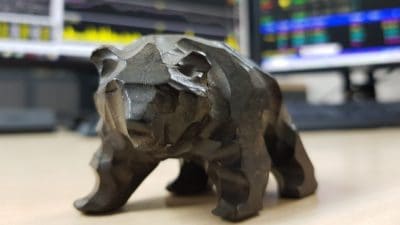Barclays (LSE: BARC) (NYSE: BCS.US) and Lloyds (LSE: LLOY) (NYSE: LYG.US) have peaked, in my view, and if volatility springs back then both stocks will likely lose 5-10% of value in a flash.
You could record decent returns out of them, but only if you time your investment properly. I’d get in at 200p-210p on Barclays, and at 55p-60p on Lloyds, seeking a 10-15% gross return — but there’s no value in either stock at these prices, I’d argue.
Capital Gains
Only under unreasonable circumstances will their shares appreciate more than 10% in the next 12 to 18 months, in my view. More likely, they’ll drop by the same amount. Barclays trades at 258p, while Lloyds changes hands at 79p.
I don’t have a crystal ball, but certain stories in finance are easily told, in my experience: that’s the case for Lloyds and Barclays, whose big fans — most analysts and brokers — have very little to lose.
Institutional investors may be attracted to both stocks, as trading volumes show, but neither bank is now worth retail money, unless retail investors are looking for a yield — that of Barclays — which could very easily be trimmed on the back of diminished cash flows, or a yield — that of Lloyds — which currently amounts to less than 1p a share.
If you are not impressed, you are in good company.
Quarterly Results
Both British banks will report their Q1 results in less that two weeks — there are plenty of reasons why you may want to avoid them.
Traditionally, May-July is not a great time of the year for Barclays shareholders, and although comparable quarterly figures aren’t incredible difficult to beat, they are not incredible easy to beat, either. The same applies to Lloyds.
Since the credit crisis, Barclays and Lloyds have become stronger entities, at least financially, on the back of more prudent strategies — and that’s exactly the reason why their profit and loss statements could disappoint investors for a very long time.
Elsewhere, the right side of their balance sheets may please regulators, but asset write-downs are still a very real risk. Barclays, in particular, could also be haunted by significant goodwill impairments.
Valuation
Quite simply, at this point in the cycle, you shouldn’t pay too much attention to earnings multiples. Trading multiples mean very little for banks right now, and should be adjusted for several one-off items that have become recurring items, as I argued in the past.
Rather, it’s the balance sheet and the cash flow statements that count most — that latter, at Barclays, suggests that the bank could cut its payout ratio.
A savvy fund manager recently told me that there are two of kind of banks in this market: there are banks you don’t want to talk about, and banks you don’t want to invest in.
In the middle there are opportunities.







